Verbs in Spanish that are completely regular in the present tense except for the
yo form are called
yo irregulars. There is an entirely new tense called the present subjunctive. This tense is based on the
yo form, so it will be extremely important to know the irregular
yo form of the useful verbs below and remember that all of the other forms of these verbs are regular. Verbs with a similar irregular
yo form are grouped together to help you remember them.
It is quite common to make verbs by adding a prefix to a simple verb. The verb with the prefix is conjugated like the simple verb, so look for examples of this at the end of each list of verbs. Also, learn to predict the conjugation patterns when you notice that a new verb has a prefix preceding a simple verb that you already know how to conjugate.
Just in case you forget the regular present tense endings of verbs, Tables , , and can help refresh your memory. The yo form is not included in these charts because it will be irregular for the first group of verbs you will learn.


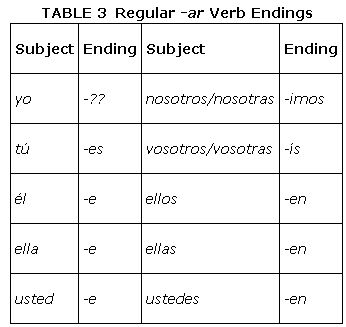
There are two extremely important verbs that are irregular only because the yo form of the verb ends in ‐oy. These two verbs are dar (to give) and estar (to be). The rest of the forms of the verbs have regular endings, but notice in Table that the verb estar has accent marks on all forms except the first‐person pronouns (yo and nosotros/nosotras). The verb dar is completely regular in all forms except yo and does not have any accents.

Another specific type of “yo irregular” includes verbs whose yo form ends in ‐go even though there is not a single g in the infinitive. The simplest and most common ‐go verbs are regular in all forms except yo, so only the irregular yo form is listed below.
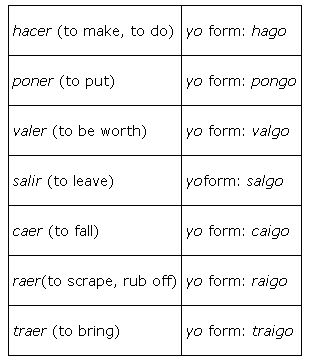
Atraer (to attract), contraer (to contract), retraer (to bring back), and sustraer (to subtract) are good examples of verbs composed of a basic verb that you know (in this case, traer) and different prefixes (a-, con-, re-, and sus‐). You should be able to predict the yo form of these verbs (atraigo, contraigo, retraigo, and sustraigo).
Three common ‐go verbs are also stem‐changing verbs. The irregular ‐go ending of the yo form is included below to keep the list of ‐go verbs complete.
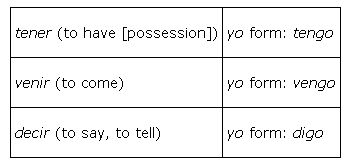
- zco verbs
Normally, you cannot predict whether a verb will be irregular in its yo form unless you already know how to conjugate the verb. There is one rule, however, that is generally consistent: If the infinitive of the verb ends in a vowel followed by ‐cer or ‐cir, the yo form of the verb will end in ‐zco. Remember, there are three common verbs that do not follow the ‐zco rule. They are hacer (to do, to make), decir (to say, to tell), and satisfacer (to satisfy). Instead, they follow the ‐go rule. Hacer and satisfacer are regular in all other forms. Decir is irregular in all forms.
The following verbs all have a yo form that ends in ‐zco. They are regular in all other forms.
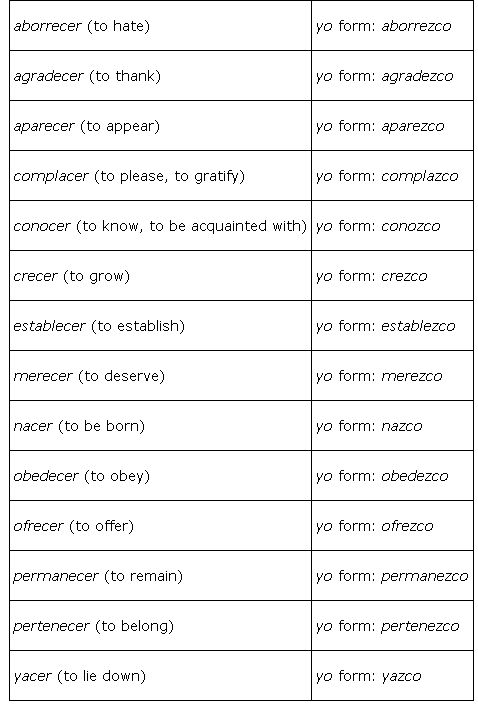
Desaparecer (to disappear) is a good example of a basic verb that you know (aparecer) and a prefix (des‐). Desconocer (to be ignorant) and reconocer (to recognize) are also good examples of a basic verb that you know (conocer) and different prefixes (des‐ and re‐).
Many verbs end in ‐ucir; these are regular in all forms but the yo form, which ends in ‐zco.
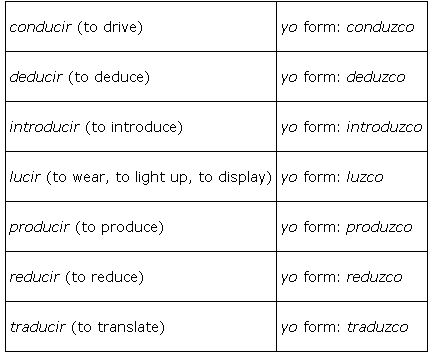
Deslucir (to tarnish) is a good example of a basic verb that you know (lucir) and a prefix (des‐).
The above verbs are grouped together because they all end in a vowel followed by ‐cer or ‐cir and, therefore, have a yo form ending in ‐zco. Another predictable irregular yo form occurs when a verb ends in a consonant followed by ‐cer or ‐ cir. In this case, the yo form will end in ‐zo rather than ‐zco.
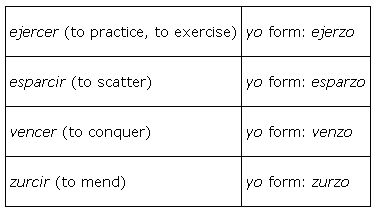
Convencer (to convince, to persuade) is a good example of a basic verb you know (vencer) and a prefix (con‐).
Verbs ending in - ger or - gir
Whenever the letter g is followed by an e or an i, it will have a soft g sound, like the letter h in English. When g is followed by o, u, or a, it will have a hard g sound, as in the English word “good.” Conjugated forms of a verb should maintain the same sound as the infinitive form. Because the yo form in the present tense usually ends in ‐ o, the ‐go ending sounds like the English word “go.” A verb that ends in ‐ ger or ‐gir must maintain a soft g sound, so the yo form will change the spelling from g to j. Some of the verbs in this list are “stem‐changers.” The stem change is included in parentheses after the infinitive, and the yo form will reflect this change. If there is nothing in parentheses after the verb, you can assume that it is regular in all present tense forms (except that the g changes to j in the yo form).
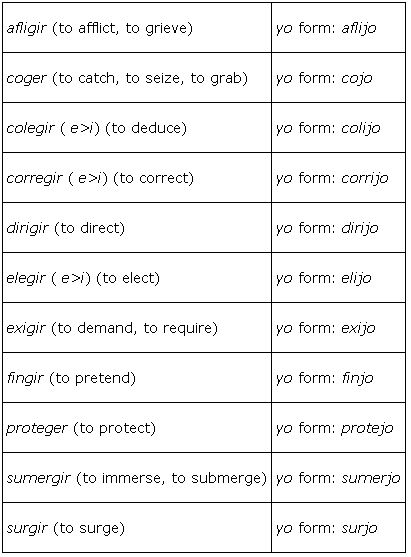
Escoger (to choose) and recoger (to gather, to pick up) are good examples of a basic verb that you know (coger) and different prefixes (es‐ and re‐). You should be able to predict the yo form of these verbs.
When a verb ends in ‐guir, the letter u is there only to maintain the hard g sound. You do not pronounce the u in the infinitive, and you should not pronounce it in any of the conjugated forms. However, when the letter u is placed between a g and an o or between a g and an a, pronunciation rules require that you say the u. Because the yo form of these verbs ends in ‐o, the u is dropped in the yo form to maintain the same sound as the infinitive. Verbs that behave like this include those listed below.
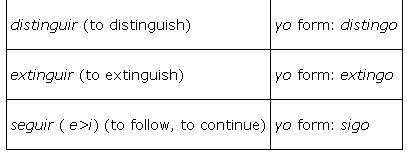
Conseguir (to get), perseguir (to persecute, to pursue), and proseguir (to continue, to proceed) are good examples of a basic verb that you know ( seguir) and different prefixes (con-, per-, and pro‐). You should be able to predict the yo form of these verbs if you remember the stem change.
Ver and saber
Two other verbs have unique yo forms: Both ver and saber are regular ‐er verbs in all forms but the yo form, but their yo forms are completely different.
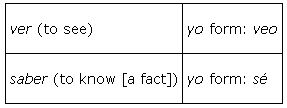
|
|
|
|
|
|
|
|
|
|
|
|
|
|
|
|
|
|
|
|
|
|
|
|
|
|
|
|
|
|
|
|
|
|
|